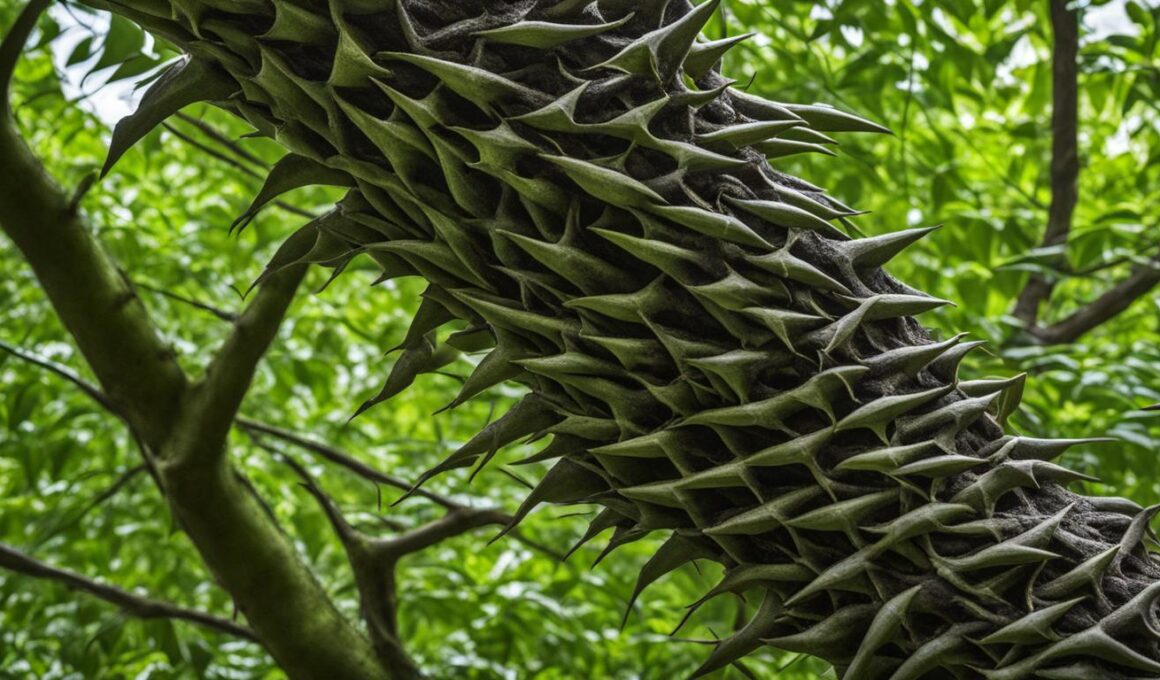Welcome to our informative article on the importance of understanding black locust tree thorns and handling them responsibly for your safety. Black locust trees, native to eastern and central US, possess stout thorns that can pose hazards if not approached with caution. It’s crucial to be aware of the potential risks associated with these thorns, as well as other parts of the tree such as leaves, bark, and seeds.
These black locust tree thorns, along with other components, contain toxic compounds that can cause poisoning in humans and animals. Ingesting these parts can lead to symptoms like nausea, weakness, flushing, lethargy, and vomiting. Severe cases may result in liver injury and seizures. Simply coming into contact with the thorns can cause skin punctures, leading to local symptoms such as pain, swelling, and rash.
Given the potentially harmful effects of black locust tree exposure, it is crucial to handle these trees responsibly, especially in areas where children and pets are present. Any instances of exposure to black locust should be taken seriously, and immediate medical assistance should be sought.
Throughout this article, we will delve further into the characteristics of the black locust tree, its benefits, and its uses. By gaining a comprehensive understanding of this intriguing tree, we can recognize and avoid potential risks associated with its thorns and other elements. Scroll down and continue reading to explore more about the black locust tree and how to appreciate its beauty while staying safe.
Characteristics of the Black Locust Tree
The black locust tree, scientifically known as Robinia pseudoacacia, is a deciduous hardwood tree native to the eastern and central United States. It possesses distinct characteristics that set it apart from other tree species.
One notable characteristic of the black locust tree is its coarse and deeply furrowed bark. This rugged bark not only provides protection against environmental elements but also adds to the tree’s aesthetic appeal.
The black locust tree is also known for its stout thorns, which are present on both the trunk and branches. These thorns serve as a natural defense mechanism, deterring animals and helping to protect the tree.
In the late spring or early summer, usually in May or June, the black locust tree blossoms with clusters of white flowers. These elegant flowers have a unique drooping shape and emit a pleasant fragrance, attracting pollinators such as bees.
During the winter months, the black locust tree produces flat, straight, or slightly curved legumes, commonly known as seed pods. These pods contain 3-10 seeds and typically measure between 2-4 inches in length. The seed pods provide a source of food for various wildlife species.
Here’s an illustration of the black locust tree to help you visualize its characteristics:
Understanding the characteristics of the black locust tree is essential for identifying and appreciating this unique species. The bark, flowers, and seed pods contribute to its distinctive appearance and ecological importance.
Benefits and Uses of the Black Locust Tree
The black locust tree is a valuable tree species that offers numerous benefits and has a variety of uses. Understanding these benefits can help you make informed decisions about incorporating this tree into your landscape.
1. Rapid Growth Rate
The black locust tree is known for its remarkable growth rate, with young trees able to grow up to 4 feet per year. This rapid growth makes it an excellent choice for those seeking to establish shade or privacy in a short amount of time.
2. Rot Resistance
The wood of the black locust tree is highly prized for its exceptional rot resistance. It is naturally resistant to decay and can withstand exposure to moisture and weathering without deteriorating. This makes it a popular choice for outdoor applications such as decking, outdoor furniture, and fence posts.
3. Erosion Control
One of the notable characteristics of the black locust tree is its fast growth and shallow root system, which makes it ideal for stabilizing soil. Its extensive root network helps prevent erosion, making it particularly beneficial for areas prone to soil erosion or landslide risk.
4. Habitat and Food for Wildlife
The black locust tree plays an important role in supporting wildlife. Its fragrant flowers attract bees and other pollinators, contributing to biodiversity and supporting the health of ecosystems. The tree’s seed pods, containing multiple seeds, are a valuable source of food for game birds.
Conclusion
In conclusion, it is important to prioritize your safety and be aware of the potential dangers associated with black locust tree thorns and other parts of the tree. The thorns can cause skin punctures, resulting in local symptoms such as pain, swelling, and rash. Furthermore, ingestion of the tree’s toxic compounds can lead to poisoning, causing various symptoms like nausea, weakness, flushing, lethargy, and vomiting.
When dealing with black locust trees, it is crucial to handle them responsibly, especially in areas where children and pets are present. Ensure that you take necessary precautions to avoid any accidental injuries or exposure to the thorns. If someone has been exposed to black locust, it is of utmost importance to seek immediate medical assistance.
By being knowledgeable about the characteristics of the black locust tree, you can better recognize and avoid potential risks. Understanding its stout thorns, toxic compounds, and other identifying features will enable you to make informed decisions when it comes to interacting with this tree species. Remember, your safety and the safety of others should always take precedence when dealing with black locust trees.
How Can I Safely Handle and Navigate Around a Tree with Thorns on the Trunk, Like the Black Locust Tree?
When approaching a thorny trunk tree discovery, like the black locust tree, it’s important to proceed with caution. Wear thick gloves and protective clothing to safely maneuver around the tree. Use pruning shears to carefully trim away any thorny branches obstructing your path. Keep a safe distance while navigating around the tree.









